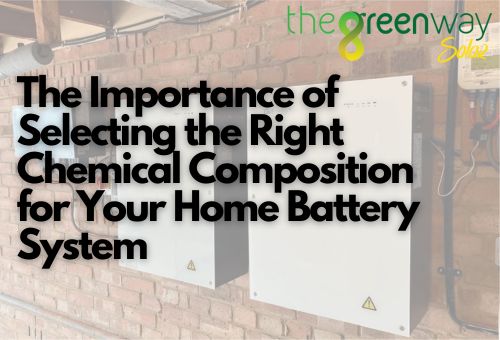

Managing Director of The Green Way Solar
When venturing into the realm of home energy solutions in the UK, the choice of the right battery storage product becomes paramount for homeowners looking to enhance their solar energy setups. The market offers a variety of options, underscoring the need to understand the implications of battery chemistry on performance, safety, and environmental impact. This guide aims to shed light on why battery chemistry is crucial and presents a case for choosing batteries like Givenergy, known for their optimal chemical composition, over others that rely on Nickel Manganese Cobalt (NMC) chemistry.
Understanding Battery Chemistry
- Safety: Safety is a significant advantage of certain chemistries like Lithium Iron Phosphate over NMC. LiFePO4 batteries are less prone to overheating and thermal runaway, a safety hazard associated with NMC batteries due to their higher energy density and susceptibility to temperature-related stress.
- Lifespan and Efficiency: Chemical construction directly impacts a battery’s durability and its ability to efficiently store and discharge energy. Batteries with a stable chemical structure, such as LiFePO4, can sustain more charge-discharge cycles with minimal capacity loss, outperforming NMC counterparts in longevity.
- Environmental Impact: The choice of materials also dictates the environmental footprint of the battery, from production through to recycling. LiFePO4 batteries often feature more eco-friendly materials compared to NMC batteries, aligning with the sustainable ethos behind solar energy adoption.
Why Choose a GivEnergy Battery?
Givenergy’s battery offerings stand out in the competitive landscape of home battery storage for several reasons tied to their chemical advantages:
- Superior Safety: Givenergy’s commitment to using safer chemical compositions minimizes the risk of accidents, offering homeowners peace of mind.
- Robust Performance and Longevity: Designed with longevity in mind, Givenergy batteries provide reliable performance across numerous charge cycles, ensuring a sustainable energy solution.
- Eco-conscious Energy Storage: Emphasizing sustainability, Givenergy batteries use environmentally friendly materials, supporting homeowners in their quest to reduce their carbon footprint.

The Case Against NMC Chemistry
- While NMC batteries can offer high energy density, which might seem attractive for energy storage, several factors suggest caution:
- Safety Concerns: NMC batteries’ higher susceptibility to overheating and thermal events poses safety risks, particularly in residential settings where safety is paramount.
- Environmental and Ethical Considerations: The extraction and processing of nickel and cobalt raise environmental and ethical concerns, complicating the sustainability profile of NMC batteries.
The choice of battery chemistry is a critical consideration for homeowners integrating solar energy systems. It influences not only the performance and safety of the energy storage solution but also its environmental impact. Opting for batteries like those offered by Givenergy, which prioritize Lithium Iron Phosphate (LiFePO4) chemistry, provides a safer, more durable, and environmentally friendly alternative to Nickel Manganese Cobalt (NMC) options. As the renewable energy landscape evolves, the informed selection of battery technology becomes integral to achieving sustainable, efficient, and safe home energy systems.











